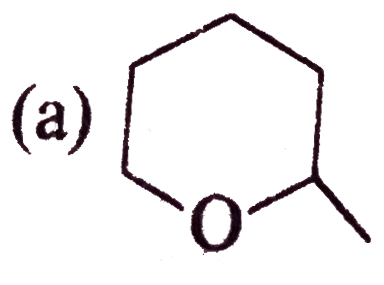Heating of 2-chloro-1-phenylbutane with EtOK/EtOH gives X as the major product. Reaction of X with Hg(PAc)2/H2O followed by gives Y as the major product. Y is :




The correct Answer is:D
To solve the problem step by step, we will analyze the reactions involved in the transformation of 2-chloro-1-phenylbutane to the final product Y.
Step 1: Identify the structure of 2-chloro-1-phenylbutane
2-chloro-1-phenylbutane has the following structure:
- A butane chain (4 carbon atoms) with a phenyl group (C6H5) at the first carbon.
- A chlorine atom (Cl) at the second carbon.
Step 2: Reaction with EtOK/EtOH
When 2-chloro-1-phenylbutane is treated with EtOK (ethoxide ion) in ethanol, an elimination reaction occurs. The ethoxide ion acts as a strong base and abstracts a proton from one of the beta carbons (the carbons adjacent to the carbon with the chlorine).
Possible elimination pathways:
1. Elimination at the beta carbon adjacent to the phenyl group:
- If the hydrogen from the beta carbon next to the phenyl group is abstracted, the double bond forms between the second and third carbons, resulting in a conjugated alkene.
2. Elimination at the other beta carbon:
- If the hydrogen from the other beta carbon is abstracted, a double bond forms between the first and second carbons, leading to a non-conjugated alkene.
Major Product (X):
The major product X will be the more stable alkene, which is formed by the elimination that results in conjugation with the phenyl group. Therefore, the major product X is:
- 1-phenyl-2-butene (where the double bond is between the second and third carbons).
Step 3: Reaction of X with Hg(OAc)₂/H₂O
Next, we treat the alkene X (1-phenyl-2-butene) with mercuric acetate (Hg(OAc)₂) in the presence of water (H₂O). This reaction is known as oxymercuration-demercuration.
Mechanism:
1. Formation of a mercurinium ion:
- The double bond of the alkene attacks the mercury ion, forming a cyclic mercurinium ion.
2. Nucleophilic attack by water:
- Water can attack either of the carbons involved in the double bond. However, due to the stability of the carbocation, the attack will occur at the more substituted carbon (the one that can stabilize the positive charge through resonance with the phenyl group).
Major Product (Y):
The product Y will be formed by the addition of an -OH group to the more substituted carbon (the one adjacent to the phenyl group) according to Markovnikov's rule. Therefore, the major product Y is:
- 1-phenyl-2-butanol (where the -OH group is added to the second carbon).
Final Answer:
Y is 1-phenyl-2-butanol.
---
2-chloro-1-phenylbutane has the following structure:
- A butane chain (4 carbon atoms) with a phenyl group (C6H5) at the first carbon.
- A chlorine atom (Cl) at the second carbon.
When 2-chloro-1-phenylbutane is treated with EtOK (ethoxide ion) in ethanol, an elimination reaction occurs. The ethoxide ion acts as a strong base and abstracts a proton from one of the beta carbons (the carbons adjacent to the carbon with the chlorine).
1. Elimination at the beta carbon adjacent to the phenyl group:
- If the hydrogen from the beta carbon next to the phenyl group is abstracted, the double bond forms between the second and third carbons, resulting in a conjugated alkene.
2. Elimination at the other beta carbon:
- If the hydrogen from the other beta carbon is abstracted, a double bond forms between the first and second carbons, leading to a non-conjugated alkene.
The major product X will be the more stable alkene, which is formed by the elimination that results in conjugation with the phenyl group. Therefore, the major product X is:
- 1-phenyl-2-butene (where the double bond is between the second and third carbons).
Next, we treat the alkene X (1-phenyl-2-butene) with mercuric acetate (Hg(OAc)₂) in the presence of water (H₂O). This reaction is known as oxymercuration-demercuration.
1. Formation of a mercurinium ion:
- The double bond of the alkene attacks the mercury ion, forming a cyclic mercurinium ion.
2. Nucleophilic attack by water:
- Water can attack either of the carbons involved in the double bond. However, due to the stability of the carbocation, the attack will occur at the more substituted carbon (the one that can stabilize the positive charge through resonance with the phenyl group).
The product Y will be formed by the addition of an -OH group to the more substituted carbon (the one adjacent to the phenyl group) according to Markovnikov's rule. Therefore, the major product Y is:
- 1-phenyl-2-butanol (where the -OH group is added to the second carbon).
Y is 1-phenyl-2-butanol.
Similar Questions
Knowledge Check
- Question 1 - Select One
Heating of 2-chloro-l-phenylbutane with EtOK/EtOH gives X as the major product. Reaction of X with Hg(OAc)2/H2O followed by NaBH4 gives Y as the major product. Y is :
A B
B C
C D
D
- Question 2 - Select One
The major product X of the reaction
 A
A B
B C
C D
D
- Question 3 - Select One
The major product X of the reaction
 A
A B
B C
C D
D
Give the major product for the reaction
 View Solution
View SolutionGive the major product for the reaction
 View Solution
View SolutionTreatment of benzene with CO/HCl in the presence of anhydrous AlCl3/CuCl followed by reaction with Ac2O/NaOAc gives compound X as the major product. Compound X upon reaction with Br2/Na2CO3, followed by heating at 473 K with moist KOH furnishes Y as the major product. Reaction of X with H2/Pd−C, followed by H3PO4 treatment gives Z as the major product.
The compound Y isView SolutionTreatment of benzene with CO/HCl in the presence of anhydrous AlCl3/CuCl followed by reaction with Ac2O/NaOAc gives compound X as the major product. Compound X upon reaction with Br2/Na2CO3, followed by heating at 473 K with moist KOH furnishes Y as the major product. Reaction of X with H2/Pd−C, followed by H3PO4 treatment gives Z as the major product.
The compound Z isView Solution2-Chloro-2-methylpropane on reaction with aqueous KOH gives X as the major product. X is
View Solution



